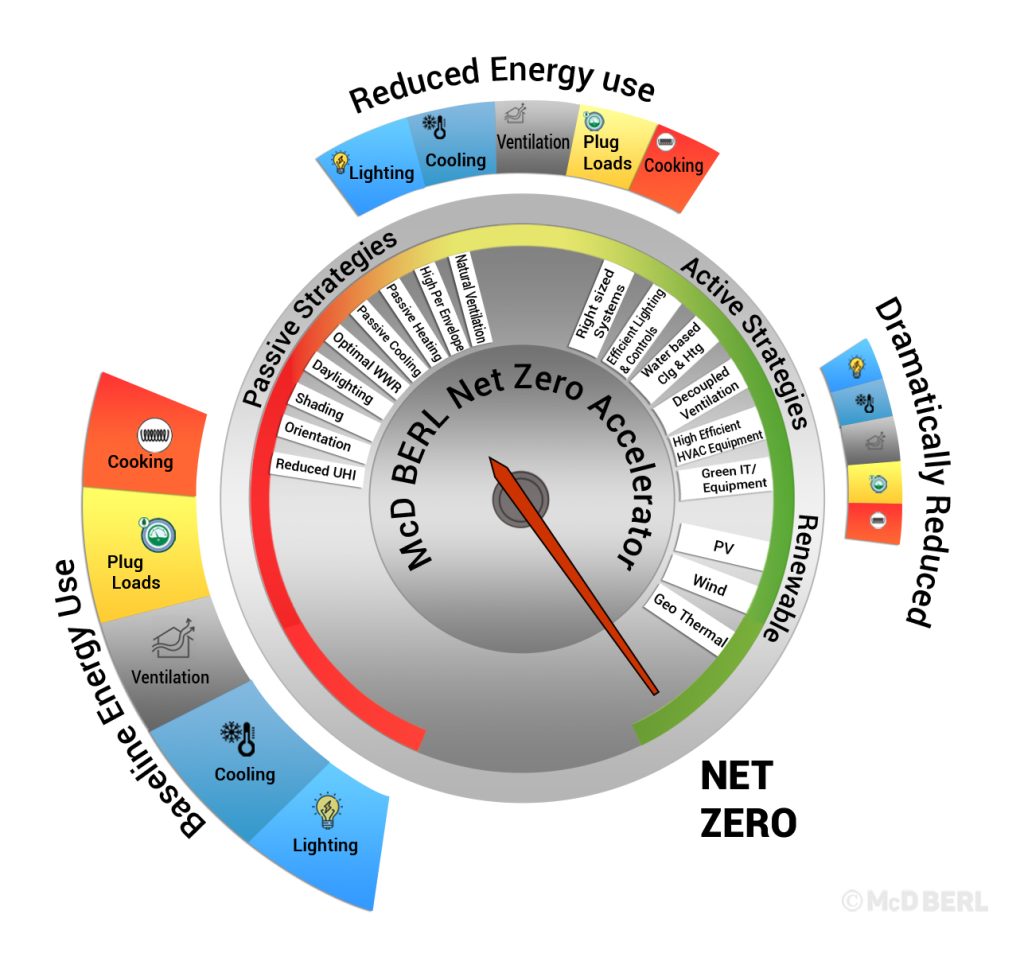Achieving Sustainability Goals with the Net Zero Accelerator

To stand out and succeed in today’s competitive market, it’s not enough to just make small efforts towards saving energy. The buildings that truly make a difference are those that include strong features for health and make big, meaningful steps towards sustainability. These buildings go well beyond the ordinary in being eco-friendly, and that’s what makes them special.
Designing a net zero energy (NZE) building involves a combination of passive and active measures, followed by the integration of renewable energy sources. Here’s an overview of the approach:
Passive Design Strategies
These are design elements that do not require mechanical operation. They capitalize on natural energy flows to maintain comfortable temperature levels, lighting, and ventilation.
Reduced UHI: Enhancing outdoor spaces for better air flow, increased green spaces, cool pavements to reduce the temperature.
Orientation and Layout: Design the building to maximize natural light while minimizing heat on the façade.
Shading and Overhangs: Implement sunshades or overhangs to block summer sun while allowing winter sun.
Daylighting: Strategically placing and sizing windows to capture optimal daylight while minimizing glare and overheating.
Optimized WWR: Tailor the WWR based on the building’s climate zone. Need to balance the daylight access, views, and improve energy efficiency.
High Performance Envelope: It consists of several key features like efficient glazing, insulated walls, insulated roof (as well cool roofs), shading devices, responsive and sustainable materials.
Passive Cooling: Using natural methods to reduce heat accumulation and promote cooling without relying on energy-intensive air conditioning systems.
Passive Heating: A design that involves the building’s design and materials to capture, store, and distribute solar heat in the winter, minimizing the need for active heating systems. The design features like maximizing solar gain, thermal mass, effective insulation, thermal buffer zones etc.
Natural Ventilation: Design for cross-ventilation to reduce the need for mechanical cooling.
Active Design Strategies
These involve mechanical or electrical systems to enhance the building’s energy performance.
Right Sized Systems: Systems are designed by performing detailed energy simulation to determine the exact heating, cooling, ventilation, and electrical loads of the building. This avoids the common problem of oversizing systems, which can lead to increased costs and energy waste.
Efficient Lighting & Controls: Use energy-efficient lighting systems, like LED, with smart controls like dimmers and occupancy sensors.
Water based Cooling and Heating: Implementing water-based systems which uses water as a medium for heat transfer, which is generally 4 times more effective than air-based system. District cooling and heating are the best examples.
Decoupled Ventilation: Decoupled ventilation is an innovative approach to HVAC design that acts independently from heating and cooling functions. This method offers several benefits in terms of energy efficiency, comfort, and indoor air quality.
Energy Recovery Ventilators (ERV): Use ERVs to exchange indoor and outdoor air while recovering energy from the exhaust.
Smart Building Management Systems: Implement systems to monitor and control energy use in real-time.
Renewable Energy Integration
Once the building’s energy demand is minimized through passive and active measures, the next step is to meet the reduced energy demand with renewable sources.
Solar Panels: Photovoltaic (PV) panels are the most common choice for on-site electricity generation.
Solar Water Heating: Use solar collectors for hot water needs.
Wind Turbines: In some locations, small-scale wind turbines can be an effective supplement.
Geothermal Systems: Utilize geothermal heat pumps for heating and cooling where feasible.
Conclusion
Achieving NZE status in a building is a multifaceted process that requires careful planning, design, and ongoing management. It’s a balance of reducing energy demand as much as possible and then meeting this reduced demand with renewable energy.
McD BERL is specialized in the design and implementation of Net Zero Energy Buildings (NZEB). With a proven track record of innovation and excellence, we offer cutting-edge solutions for sustainable building design.
Are you planning a Net Zero Energy Building project? McD BERL is here to bring your vision to life with our expertise and innovative solutions. Contact us to discuss how we can meet your project requirements and set new standards in sustainable building design.




